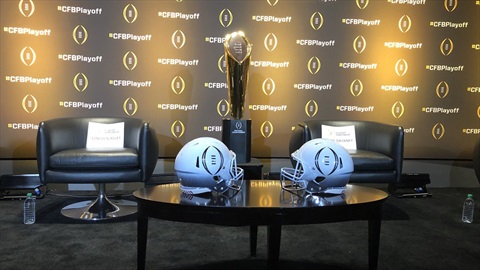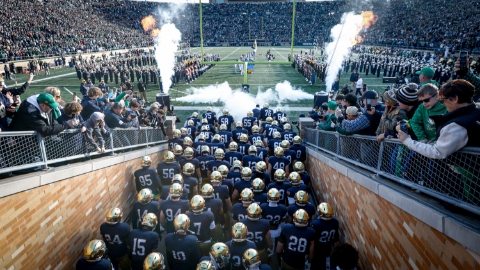
Notre Dame leaned hard into the “Tight End U” label last season. Their base personnel on offense was 12 (one back, two tight end). At times they played with three or four tight ends on the field and together with a veteran offensive line, it became a ball control offense that zagged while most other teams zigged. They finished 17th in FEI’s offense rating.
It worked pretty well for them, but ultimately not well enough for them to take that next step against Clemson and Alabama to end the season. After winning their first 10 games, they lost the last two scoring a combined 24 points (14 of which came in garbage time).
They need to be better on offense to compete at the highest level. Playing the style they did against Alabama might have been the smart move considering how they were outmatched on defense, but the success they had this season will be difficult to replicate playing the exact same way unless they can find more ways to be explosive.
22 of their 63 drives that ended in points this season (34.9%) took 10 plays or more for them to score. Nine of those 22 ended up with field goals, which shows how difficult it is to get into the end zone with longer drives.
It forces an offense to be perfect for too long, which is why there is a need for more explosive plays.
The Irish had a play of 20 yards or more every 14 plays. That’s down from every 11 in 2019 and a far cry from the rate that of top teams they are competing with.
Ohio State averaged an explosive play every 10.9 plays in 2019 and every 9.4 plays this season. Alabama was at 8.8 and 10.4 the last two years. Even with significant injuries at the wide receiver position, Clemson was at 11.1 in 2020. They were at 10.8 per in ‘19. The 2019 national champion, LSU, averaged one every 9.6 plays.
Teams who are explosive on offense score more points said Captain Obvious. I know it’s something that most observers understand, but it does need to be reiterated.
I did a piece on 30 being the magic number for Notre Dame last April. Here’s what I wrote then about the Irish scoring on drives when they had a gain of 30 yards or more.
(In 2019) when the Irish had a drive that included a play of 30 yards or more, they scored points 93.8% of the time. 84.3% of those drives resulted in touchdowns. The average points per drive was 6.19. That’s not just a one year anomaly for them.
Over the last three seasons, they averaged 6.03 points per drive on 99 offensive series. They scored on 93% of drives and scored touchdowns on 81.8% of them. There were only seven drives when a drive that included a play of 30 yards or more didn’t result in points. They were almost all scoring opportunities, it was just that Notre Dame failed to cash in on them (like missing a field goal against Virginia or throwing a red zone interception against Virginia Tech).
Only once they did have a play of 30 yards or more and end up punting. So, big chunk plays are pretty important when it comes to scoring points and scoring points means winning games.
They matter a lot in the big games too. The Irish only had one play of 30 yards or more against Georgia in 2017 (scored 19 points in a loss). They had zero against Michigan last fall (14 points in a loss). They were almost upset by an inferior Virginia Tech team at home and had only one play of 30 or more in a one point victory (21 points).
They had zero against Clemson in 2018 (3 points). They had zero against Miami in 2017 (8 points). They had two against Georgia in 2019 (17 points). No one is beating any opponent scoring single digits in a game. It’s incredibly difficult to win scoring less than 20 in college football. A few big plays sprinkled into the two Georgia games could have changed the outcome.
That’s how it looked in previous years. This is how it broke down this season.
The numbers are down with 16 touchdowns on 22 drives that included a play of 30 or more (72.7%). They averaged 5.2 points per drive and had points on 77.3% of those drives. The five times they didn’t score any points on drives were a pick from Ian Book vs Duke, the turnover on downs vs Clemson in the ACC Championship game, Book’s fumble against Clemson at home, a missed field goal vs USF, and a missed field goal vs UNC. All of those were scoring opportunities.
On drives without a big chunk play, Notre Dame only scored touchdowns 30% of the time. So, again, they’re pretty important.
The percentages got worse in 2020 because of the lack of success in the red zone. Notre Dame’s red zone inefficiency made it an even more glaring issue. They were 84th in red zone touchdown percentage. On 60 trips to the red zone, they only scored touchdowns 35 times.
If the red zone is the most important thing the Notre Dame coaching staff needs to figure out this offseason, then explosive plays are right behind it on the list. They need to be better there if they want to be a national championship program.
They couldn’t win the most important games because of it. They didn’t have a play of 30-yards or more against Alabama. They had one against Clemson in the second matchup. They almost lost to an inferior Louisville team when they had zero plays of 30. It’s not a coincidence that those games were the worst scoring games for the Irish all season.
Notre Dame went from the third best Power 5 team in points per drive behind Alabama and Ohio State to seventh after the final two games.
So how did they get worse and how can they get better? The personnel at wide receiver played a part with them getting worse.
Not having a Chase Claypool was a big reason why. He had 23 receptions of 20 yards or more as a senior. The only two Power 5 receivers with more were LSU’s Ja’Marr Chase and Oklahoma’s CeeDee Lamb. Kevin Austin was supposed to replace some of that production, but an injury didn’t allow that.
The same could be said for Braden Lenzy who averaged 18.8 yards per rush and 24.7 yards per reception the previous season. A hamstring injury took him out of the lineup for a good portion of games. He touched the ball once after October.
They clearly have to find more big play production from the wide receiver position and they’re losing the only guy who had more than 8 receptions of 20 yards or more (Javon McKinley had 12).
The first thing that comes to mind for most people with passing game improvement is the vertical passing game. There is no doubt that Notre Dame can be better in that area and not having a Claypool or a Miles Boykin was a reason the Irish took a step back in that area with Book finishing seventh in completions with 20 air yards or more in 2019 and then dropping down to 33rd (even with several conferences playing less games).
They need to find a McKinley replacement who can increase that production.
In addition to that, they need to find ways to gain way more yards after the catch. Avery Davis finished 19th in the country in average yards after the catch. Getting him more opportunities in space would be a good start in finding more explosive plays through that avenue.
It’s critical that he’s not the only one, though. They need more players who can make a big impact with YAC whether that’s returning players or a freshman like Lorenzo Styles Jr.
All of that doesn’t necessarily mean they have to get away from running the football as much. They just need to find ways to be more explosive doing it. The 2017 Notre Dame offense is an example of how an offense can be explosive running the ball. They had 42 runs of 20 yards or more and the overall explosive play rate was 11.1.
Lenzy had 13 carries in 2019. That number was likely going to increase, but he only had three because of his availability. Davis would have been the guy to replace some of that, but he only had three as well. He averaged 19 yards on those three.
Finding ways for someone like him to get the ball more as a runner and getting Lenzy back involved is one way to produce more big plays running.
Utilizing play-action more is another way. Notre Dame’s only 30 yard gain in their final two games came off a bootleg where Book found Tommy Tremble for 30 yards. They need more plays like that, but for whatever reason, didn’t use a lot of play-action with the passing game.
Tommy Rees only called play-action passes on 22.8% of drop backs with Book at quarterback. That’s tied for 93rd in the country for quarterbacks with 99 or more drop backs this season. However, Book was 29th in yards per attempt off of play-action throws. His 9.3 YPA was 1.8 higher than on throws that weren’t off of play-action.
We may see more of a shift in personnel this year, but having success running the football is still going to be a foundational part of the offense for the Irish. They need to be more explosive passing the football, though, if they want to win a national championship. Rees only has to look at the last two offenses for the teams that won it all to see what he is up against.
No one stopped LSU in 2019 and no one stopped Alabama in 2020. The only way to beat them was to outscore them. Shortening the game against Alabama was a wise move given the circumstances, but it only would work if the Notre Dame offense could score at the same rate Alabama did.
If they want to do that, they need less long drives and more big plays. Offense wins championships right now. Notre Dame has to do what they can to keep up. They can continue to zag with personnel, but must get better to keep up with the others who are zigging.



